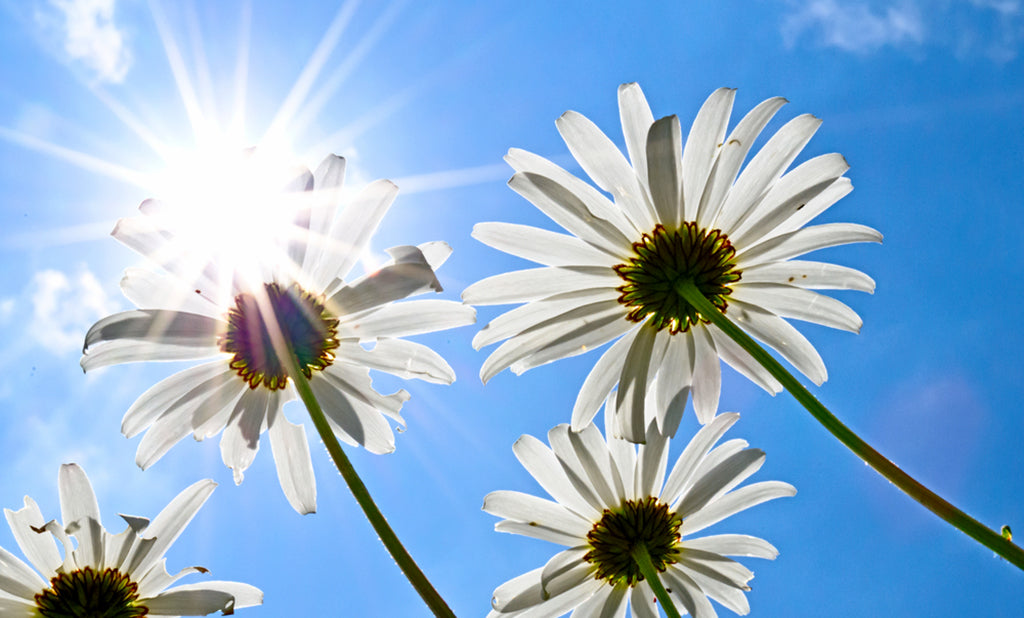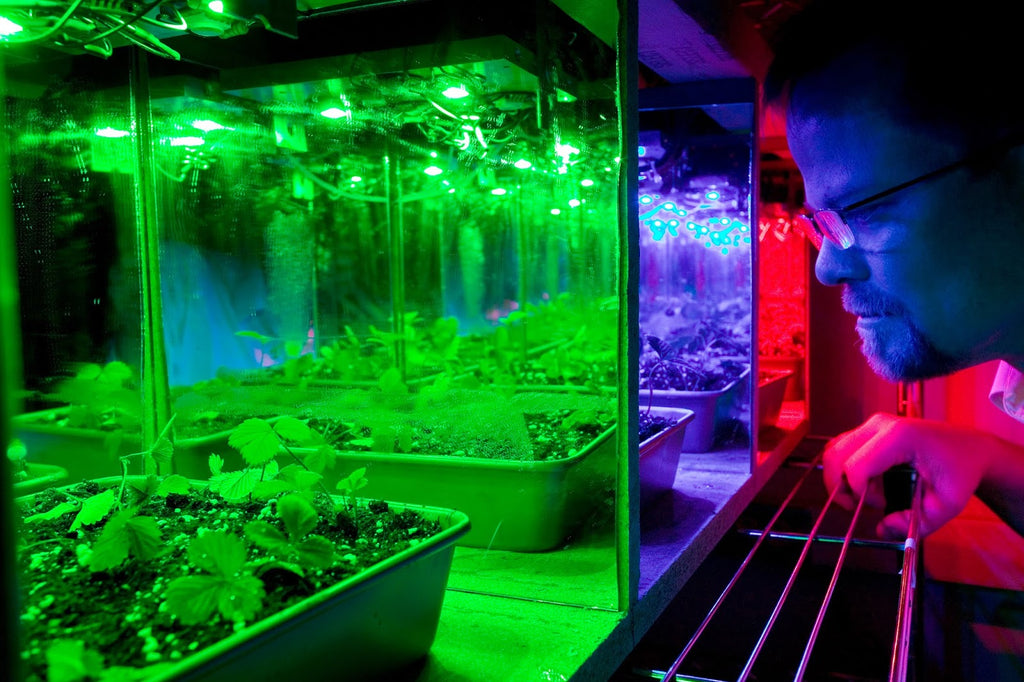What Plants See: Separating Lumens from Effective PAR (EPAR)
 Introduction
Introduction
The lighting industry has experienced three revolutions, namely, the hot filament incandescent, gas discharging florescent and HID, and recently solid state LED. For plant growth and hydroponic applications, the second generation florescent and HID still dominate the market, and its lumen per wattage concept is prevalent in our general knowledge of horticulture lighting.
In the coming age of LED lighting, the concept of color rendering index (CRI) and lumen are about to be updated when considering the human eye’s cone cell and rod cell sensitivity [1, 2]. Likewise, different plant responses to light spectrum differently at various biologic stages such as rooting, vegetative growth and budding. This essay will cover the impact of Lumen, which is based on human vision, then Photo-synthetically active radiation (PAR) [3], and lastly more advanced Effective PAR concepts.
The Human Eye and Lumens
There are two ways to measure the "amount" of visible light – in Radiometric, using power of wattage for the light wave, while Photometric is in the term of perceived brightness by the typical human eye. A Lumen is a photometric unit, however Ultraviolet Light (UV) and Infrared Light (IR) are two bands of the light spectrum which the human eye can’t see, their lumen value is zero. Therefore, UV and IR can only be denoted by Radiometric units. The measurement of Lumen value is the weighted summation of radiometric spectrum power against the human photopic luminous efficiency, see Figure 1. Human photonics efficiency peaks at 550nm yellow wavelength and dwindles down above or below 555nm. Therefore, for light with a lot of yellow spectrum , such as High Pressure Sodium (HPS), will have a higher lumen value for a given wattage power of light, though the human eye will process that level of light with less efficiency.

Figure 1: The typical Spectrums of a incandescent, HPS and phosphor converted white LED and human eye response curve.
Photosynthesis and PAR
Similar to the human eye response to light, plants absorb energy from light through the photosynthesis process. Chlorophyll is the main carrier for photosynthesis and this is what gives leaves their green color due to their spectrum preference. In photosynthesis, the reaction is carried out at the atom and photon level. The speed of reaction is related to the amount of energy present and the number of photons. It is not directly related to a light’s lumen output. PAR value is thus introduced to measure of number of photons that have participated in the reaction. The PAR value measurement can either be through a weighted photon-count or energy weighted as shown in Figure 2.
When measuring through a weighted photon count, PAR is quantified as µmol photons m−2s−1, which is the unit for photosynthetic photon flux area density. PAR as described above does not distinguish between different wavelengths between 400 and 700 nm, and assumes that wavelengths outside this range have zero photosynthetic action.
By weighting energy factor to different wavelengths according to photosynthesis response, the photosynthetic photon flux density (PPFD) values in μmol/s can be modified to the yield photon flux (YPF) as shown in the red curve of figure 2.

Figure 2: The photon-weighted curve is for converting PPFD to YPF; the energy-weighted curve is for weighting PAR expressed in watts [3, 4]
Chlorophyll , Carotenoids and Effective PAR
PAR value is measure of photons in the range of 400nm to 700nm. The yield photon flux extend that range to 360nm to 760nm and weigh the measurement according to plant photosynthetic response [4]. Both PAR and YPF are much better parameters than lumen in quantifying actual photosynthesis. However, research has found that light interaction with plants is far more complicated than counting photons in the visible range. For instance, both IR and UV may play important roles as various stages for difference species. More importantly, different biological reactions need different spectrums and too much light may not be desirable [5].
PAR and YPF ‘s imperfection can be seen in Figure 3, where in three major components, namely Chlorophyll a, Chlorophyll b and carotenoids, are drastically different from the weighting factor for PAR as shown in Figure 2. Chlorophyll a is only one form of Chlorophyll that absorbs mostly violet-blue and orange-red light and reflects green- yellow light, which contributes to the observed green color of plants. However, Chlorophyll b is another type of chlorophyll that primarily absorbs blue and red light. Besides Chlorephylls, carotenoids are also essential for horticulture. The key carotenoids include lycopene, vitamin A precursor β-carotene, and xanthophyll lutein, which is a vital nutrient in preventing age-related eye disease. Carotenoids are often masked by green tint from chlorophyll. When chlorophyll is absent, such as seen in autumn leaves, carotenoids give the vibrate display of yellow, orange, brown and red. Carotenoid colors are also predominate in ripe fruits where chlorophyll is not present.
Comparing Figure 2 and 3, we will see that the weight factor of PAR in Figure 2 is the summation of the Chlorophyll a and b response curves. To distinguish the spectrum effects on individual process such as rooting, vegetative and flowering, the weight factor in Figure 3 needs to be further modified as well as the photon at the right wavelength is effective. Therefore, Effective PAR (EPAR) value is a better metric than that of PAR and YPF. The Effective PAR weighting factor covers a larger spectrum range and is not a fixed curve. EPAR will be different for each species and specific to stages such as rooting, vegetative growth and flowering, etc.
DemeGrow Spectral Smart LED grow lamps have been designed to optimized the Effective PAR recipe for vegetative and flowering modes of a plant’s lifecycle. More importantly, the multi-diode, multi-channel design allows experienced user to define the recipe on wavelength to maximize Effective PAR depending on the plant subject including complete control over intensity on each wavelength channel as well as timing for photoperiodic control.

Figure 3: Typical PAR action spectrum, shown beside absorption spectra for chlorophyll-A, chlorophyll-B, and carotenoids [3]
References:
“Luminous efficacy of white LED in the mesopic vision state”, Peng Jin, et al. Optoelectronics Letters, July 2009, V5, P265-267;
“Spectral Effect of multi-chip LED on Color Contrast Sensitivity with SPD Tuning”,Peng Jin, Liting Jiang, Solid-State and Organic Lighting, Canberra Australia, December 2-5, 2014
“Photosynthetically active radiation”, Wikipedia
“Accuracy of quantum sensors measuring yield photon flux and photosynthetic photon flux.” Barnes C, et al . HortScience. 1993 Dec; 28(12):1197-200.
"The phenomenon of photoinhibition of photosynthesis and its importance in reforestation". Alves P, et al. The Botanical Review 68 , 2002.

Written by Dr. Peng Jin
Technical Director/Owner, DemeGrow, Inc.
Director, Green Lighting System Center at Peking University
Research Area: Horticulture lighting, smart lighting and human color vision


 Introduction
Introduction


 This sounds like science fiction, but it isn’t. At the recent Science Writers 2013 conference in Gainesville, FL, Dr. Kevin M. Folta (pictured, right) of the University of Florida showed us his vision of growing plants in the future. In this world, there will be automatic lighting systems and reflective surfaces that use varying colors of light to fine-tune a plant’s nutrition, flavor, texture and many other attributes.
This sounds like science fiction, but it isn’t. At the recent Science Writers 2013 conference in Gainesville, FL, Dr. Kevin M. Folta (pictured, right) of the University of Florida showed us his vision of growing plants in the future. In this world, there will be automatic lighting systems and reflective surfaces that use varying colors of light to fine-tune a plant’s nutrition, flavor, texture and many other attributes.